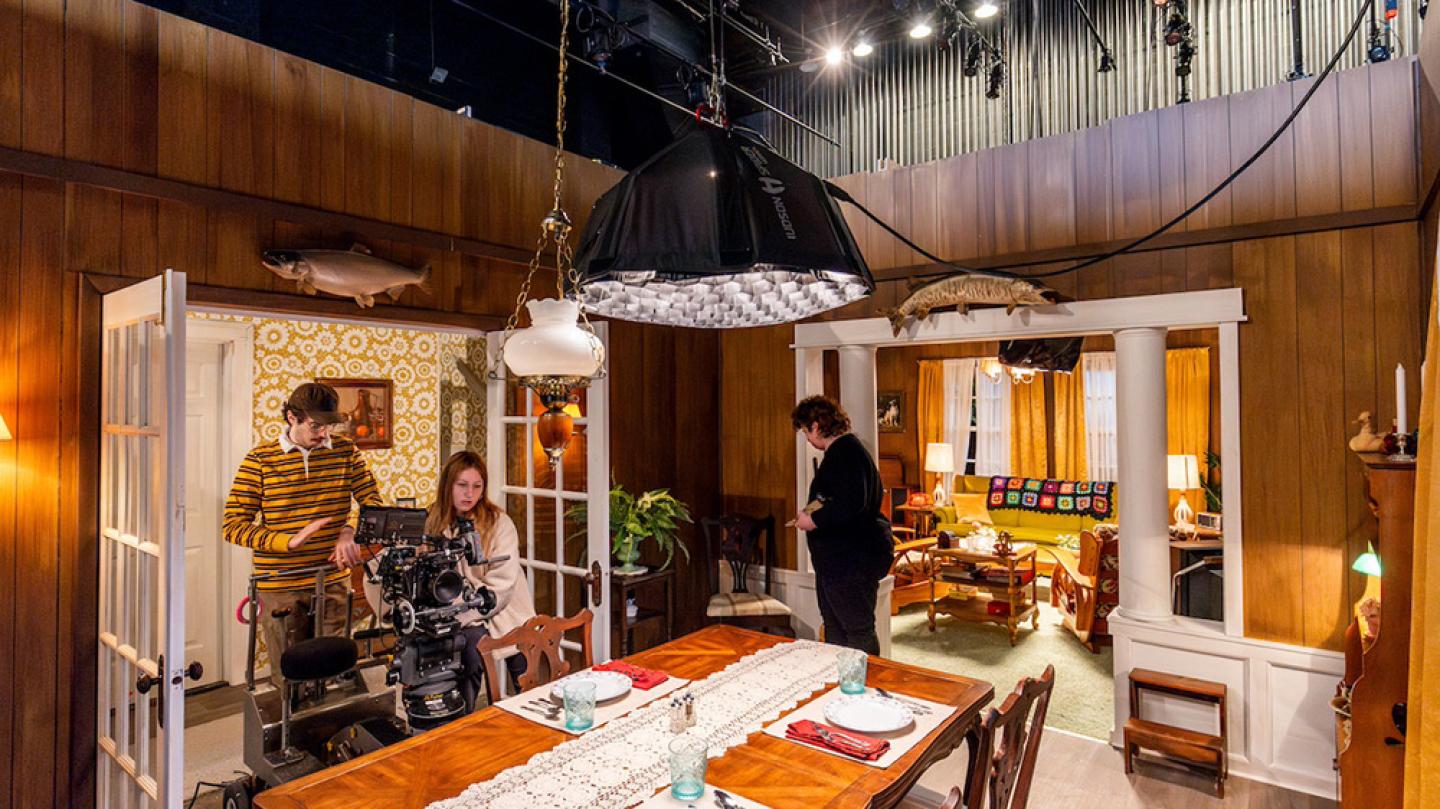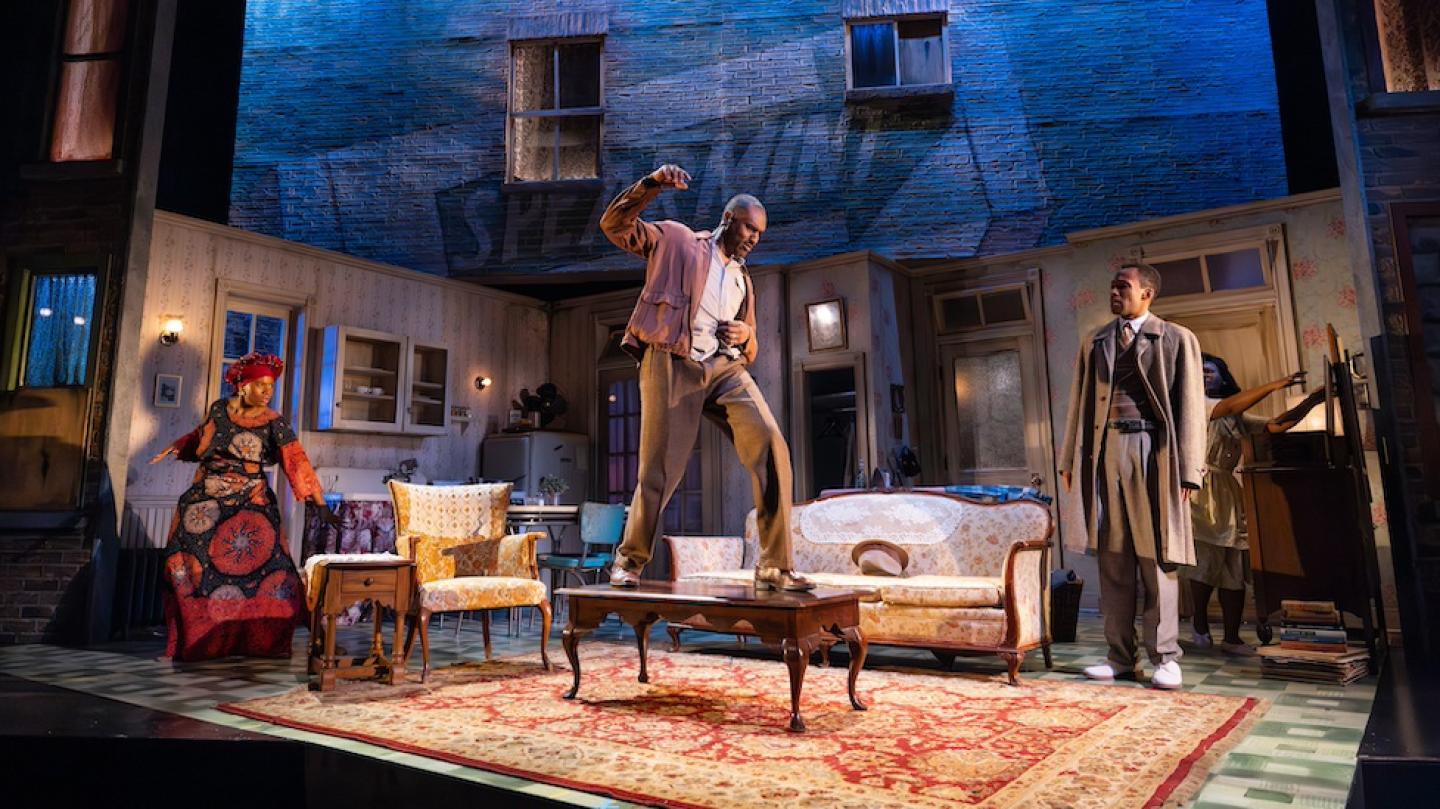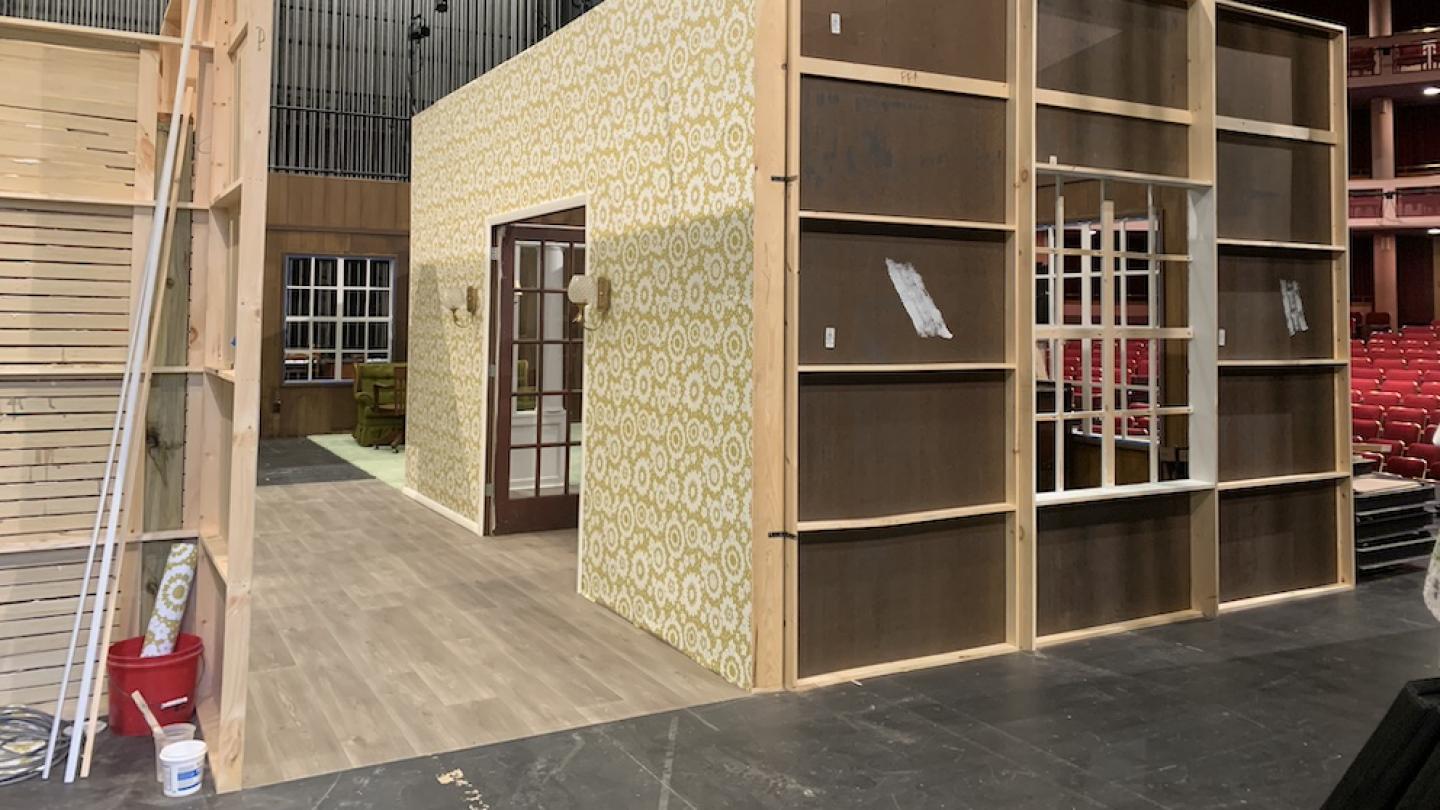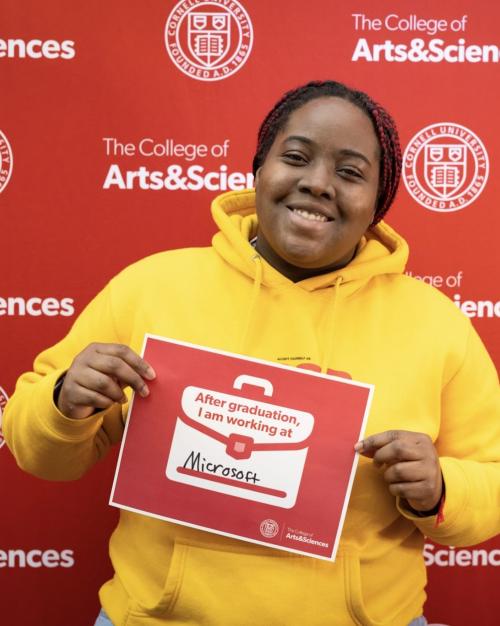The room on the Kiplinger Theatre stage is paneled in wood and faded yellow-green floral wallpaper. The lamps, beige and dim, barely disturb the shadows dominating every corner. Old family photos march up the wall. A taxidermy deer head gazes down upon a mustard yellow couch draped with a crocheted color-block throw. The stairs, carpeted in gray shag, look as though they might creak under the weight of the tragedy haunting the house.
The shiver-inducing story of the old couple living in that house and a young man who stumbles upon it took root in student filmmaker Peter Levine’s ’24 imagination two years ago. The resulting short film, “Remembering Colin Stall,” came to life this semester on a set installed on the stage.
Designed by Jason Simms, assistant professor of performing and media arts (PMA) in the College of Arts and Sciences (A&S) and built by PMA crew and students, the film set was the busy heart of the Schwartz Center for the Performing Arts for the first half of the spring 2024 semester.
It was an all-hands-on-deck experience for PMA this spring, said Simms, with many hands-on learning opportunities. Students got involved building, painting, decorating (or “dressing”) the set. In mid-February Levine directed a crew of students and industry professionals in shooting the film, which is Levine’s thesis project in the Robert S. Harrison College Scholars Program. After that, the set became an experimental zone for film and theater technology classes.
“It was a pop-up laboratory,” Simms said. “It definitely took on a life outside ‘Colin Stall,’ which was always part of our intention.”
Laboratory for a story
Levine laughs when he remembers the very first seed of “Remembering Colin Stall.” In a Cornell film writing course, he was trying to create a heart-felt tale about an old couple helping a kid who got lost near their home in the countryside.
“This couple that lives here, their life took place between the 1960s and the 1980s. Then their son died, and they got stunted. They haven’t moved forward in time,” said Levine. “When Jude, a young man running away from home, breaks down outside their house, the elderly couple takes him in.
“I presented it to the class and every single person said ‘this is terrifying,’” he said. “Out in the middle of nowhere, an old couple in their farmhouse. As nice as you want to make it feel, that’s horror. It’s what we expect.”
Levine decided to run with it and grew the script into his thesis project, using GoFundMe and a grant from the Lynne S. Abel ’62 College Scholar Endowment Fund to hire professional film crew and actors. Cinematographer Indeana Underhill signed on as director of photography gratis and Simms agreed to design the production.
In addition to being a professor, Simms is an award-winning scenographer, with more than 150 productions to his credit. His portfolio is full of theater, dance, opera and virtual reality credits at regional and New York City theater, including “Murder on the Orient Express” for the Pioneer Theatre Company in Salt Lake City, Utah; “A Raisin in the Sun” for Bristol Riverside Theatre in Bristol, Pennsylvania; and “The 25th Annual Putnam County Spelling Bee” for George St. Playhouse in New Brunswick, New Jersey.
Simms is also the production designer for “Fish,” a new play by Kia Corthron, which began previews March 21 at Keen Company in New York City. He’s designed recent shows in Ithaca, and others for Cornell PMA. But the expressive vision he shares with his students extends far beyond the walls of any set.
“I’m not a set design teacher, I’m a world-building teacher,” Simms said.
He started planning the “Colin Stall” set by collecting images: wood-paneled country houses with dark lighting and fireplaces; vintage 1960s living room photos with family portraits and plaid armchair upholstery.
He also made a 3D computer model, a useful device for visualizing the space. “This will be a world,” he said, scrolling through the model back in January. “It’s country chic horror. Grandma’s attic meets Norman Bates.”
“Jason has a database in his head of architectural knowledge and period knowledge,” Levine said. “He knew exactly what I was going for.”
Simms made plans, then handed them over to Savannah Relos, assistant technical director in PMA (A&S) to actualize, in a collaboration much like an architect and an engineer.
“Jason is aware of the aesthetic of the world, the final picture. It’s my job to take it and make sure it’s going to hold weight, it’s going to support whoever it needs to support,” Relos said. “I’m the reality check.”
Relos said the “Colin Stall” set was much like theatrical sets she builds routinely on the Kiplinger stage, but with some key differences. Unlike a theater set, the film set didn’t have to be open on an audience side, which made bracing the walls simpler. But details were more important, making the finishing touches more laborious. Like the wallpaper, for example.
“If I’m building a theater set, I will paint, I will stencil, I will even use fabric because it’s just an easier medium to work with than wallpaper – all the paste and the tearing,” Relos said. “But for this film set, because the camera is right there, actors are going to be up against the walls. You’re going to be able to tell if the wallpaper’s not real and it will be distracting for the story.”
Extreme makeover home edition redress
Levine and his crew filmed “Remembering Colin Stall” in one long weekend. They wrapped around Feb. 20, and the set’s role as an experimental zone began.
Simms’ production design students teamed up with film classes taught by Jeffrey Palmer, associate professor of performing and media arts (A&S) and Doorim Kim, lecturer in PMA, to transform the set for another project.
“The film class came up with a short script and my production design students did sort of an extreme makeover home edition redress of the set so it could serve the script the students in the film class wrote,” Simms said. The students were challenged to create a whole new look and feel on the set—without bringing in any new props or elements. “That was a lot of fun.”
Simm’s course, Project: Terrarium Imagined; World Building through Allegory, in which students design a fictional society from the ground up, spent time on the set, too.
“I used that opportunity to talk about character because when you actually dress a set you’re thinking about the people who live there and what they have and what their world is,” Simms said. “It was a great opportunity again to use this physical laboratory as an example of why this is important.”
As a member of Simms’ production design course, Sid Martis ’25, an architecture student in the College of Art, Architecture and Planning, helped to paint and dress the film set, taking away lasting lessons for his future profession.
“The most important skill in my mind is the actualization process in the creation of any occupiable space,” Martis said. “In architecture, that has also been a challenging jump. It's easy to create a space that's pretty, but it's much harder to create a space that can be occupied by a cast. I feel like on a deeper level, the class is informing me on how to create spaces for others rather than for myself.”
On the precipice of something new
The film set went up, a world appeared and transformed into other worlds and inspired still more. And then it all vanished. By mid-March, Relos and her crew struck the film set to make way for rehearsal and performance of an April 25-27 dance event, the culmination of this year's Choreographing Justice Series, for which Simms will transform the space yet again, a totally different look.
Meanwhile, “Remembering Colin Stall” is in editing. Levine will have a cut of the film ready for the early May student film show and will discuss his project at the Harrison College Scholar Program senior thesis presentations on May 4. And of course, the experience will live on in the minds of the students who participated.
Simms said he’s excited about the many directions students can take skills they learn in PMA: “I think we’re on the precipice of something new in media/performing arts, where they’re going to have to develop a wholistic skill set that could encompass game design, design for film, virtual reality worlds, virtual worlds, immersive – actual in person immersive experiences, high-quality theater and anything else that could possibly fit under that umbrella. It’s a wide umbrella, and I’m excited about the future of it. I recognize that innovation is about to happen.”
In the near future, PMA is considering another film set for the Kiplinger stage next year.
“It was exciting to have something of that scale in our building, in the Schwartz Center. It opens the door for more projects of that scale to happen within PMA,” Simms said. “I think we will see more of this.”








